Freezing Sourdough Bread Dough
This post may contain affiliate links.
Life doesn’t always go according to our baking schedule, does it? Sometimes you’ve mixed up a beautiful batch of sourdough dough, only to realize you won’t have time to bake it. The good news is, you don’t have to waste it! Freezing sourdough dough is a fantastic way to press pause on the process so you can bake fresh bread, rolls, or even pizza another day. With just a few simple steps, you can save your dough at the right stage, keep all that flavor you’ve worked so hard for, and pick up right where you left off when you’re ready.
You can basically have loaves of sourdough bread whenever you want them, baked right from your freezer. I've done countless experiments to establish the best method of taking sourdough bread dough from the freezer to the oven, so you can be sure you'll find a way to do it for yourself.
If you've already baked your sourdough bread, this guide on freezing sourdough bread will help you navigate the process. Sourdough bread freezes incredibly well, but this guide deals with freezing the dough before baking, rather than after. You can also read about freezing sourdough pizza dough and freezing sourdough starter.
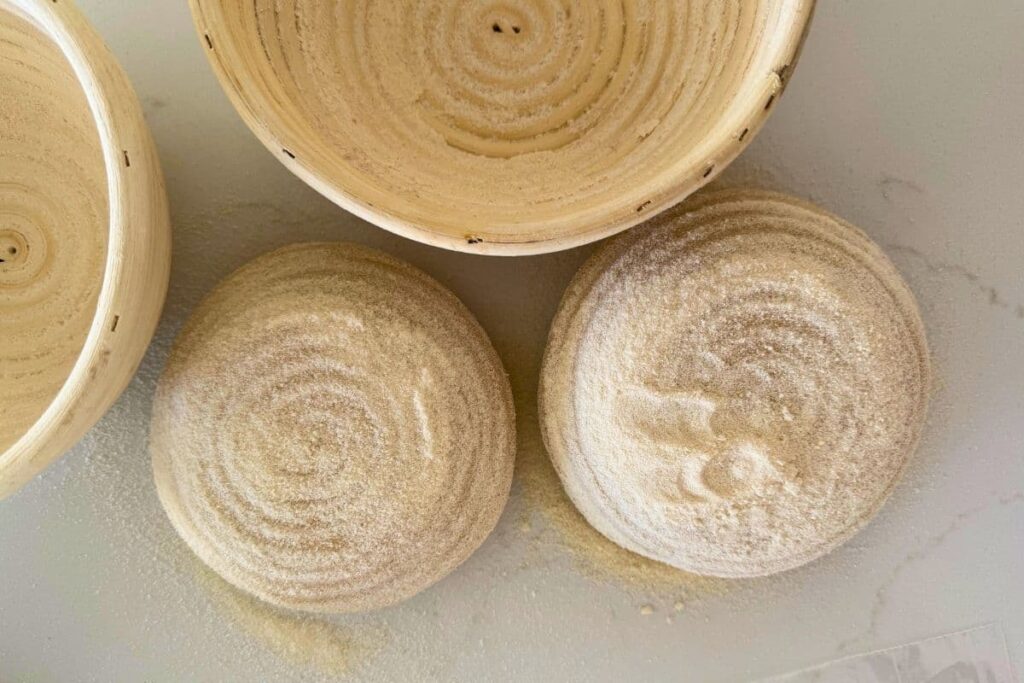
Benefits Of Freezing Sourdough Bread Dough
There are lots of reasons you might want to freeze sourdough bread dough, rather than baking it first. You need to remember that in freezing sourdough dough, you're dealing with wild yeast, which can be a little more unpredictable than commercial yeast and yeasted dough.
- Saves time on busy days – You can do the messy, time-consuming part (mixing and bulk fermentation) when you have the energy, then freeze the dough and bake another day when your schedule allows. Shaped dough will last in the freezer longer than it would in the fridge, perfect when you have a busy schedule.
- Reduces food waste – Instead of tossing dough that you might have forgotten in the fridge or you know you aren't going to get around to baking, freezing gives it a second chance at becoming sourdough bread.
- Bake fresh bread on demand – Keep dough in the freezer and pull it out whenever you want a fresh loaf, rolls, or pizza without starting from scratch.
- Improves flavor in some cases – Just like cold fermentation, freezing can slow the process and add more complexity to your bread’s flavor.
- Great for meal prep – If you like to batch your baking, you can make several portions of dough at once, freeze them, and then bake fresh bread throughout the week or month.
- Perfect for small households – If you don’t need a whole loaf at once, portion and freeze smaller dough balls so you can bake just what you need. You might like this method of dividing sourdough after shaping.
When Is the Best Time to Freeze Sourdough Dough?
- After shaping and cold fermentation - this provided the best end result for the baked sourdough.
I've experimented so much with this over the past few months to find the best time. I've frozen balls of dough after bulk fermentation, but before final shaping and then after shaping but before final proof. A lot of the things I tried affected the structure and integrity of the dough.
How To Bake Sourdough That's Been In The Freezer
I've experimented a lot with this process lately and I've documented the ways in which I tested baking the frozen sourdough:
Thawing the Dough - I tested thawing the dough first, but found that this can be too unreliable. You also need to put it back into a banneton and either leave it in the fridge or on the counter or else it loses its shape and doesn't bake properly.
Baking From Frozen - Place the frozen dough onto a piece of parchment paper and then place into a hot Dutch oven. Bake for 45 minutes with the lid on and 15 minutes with the lid off. The increased baking time is to account for the thawing process which occurs inside the Dutch Oven. You could also bake your dough without a Dutch oven, however I highly recommend using the Dutch oven because it traps the steam inside and results in a better crust.
How to Freeze Sourdough in the Banneton
With Parchment Paper
The first method I experimented with was freezing the dough inside the banneton, lined with a piece of parchment paper. The steps I took were:
- Mix, bulk ferment and shape the sourdough as per normal.
- Sprinkle a generous amount of semolina flour onto a piece of parchment paper. Place the shaped sourdough onto the semolina lined parchment paper.
- Use the parchment paper to lift the shaped sourdough into the banneton.
- Cover with plastic and allow to proof for around 30 minutes on the counter before placing the banneton into the fridge. I left the dough in the fridge for 6 hours before placing it into freezer to freeze through.
- Once the dough is frozen through, use the parchment paper to remove from the banneton and place into a ziplock bag (with or without the parchment paper).
This method worked fine, however I found that the parchment paper gave the dough a crinkly edge. If you don't mind this, then the parchment paper definitely makes it easy to move the dough around. I also found that when I baked this one, it burst open quite a lot and maintained the crinkly edges.
Without parchment paper (semolina lined banneton)
After seeing the issues with using parchment paper, I then tried the method without the parchment paper.
- Mix, bulk ferment and shape the sourdough as per normal.
- Sprinkle a generous amount of semolina flour into a banneton. Place the shaped sourdough into the banneton.
- Cover with plastic and allow to proof for around 30 minutes on the counter before placing the banneton into the fridge. I left the dough in the fridge for 6 hours before placing it into freezer to freeze through.
- Once the dough is frozen through, tip it out of the banneton (this should be fairly easy if you've used enough semolina flour).
- Place into a ziplock bag and into the freezer until you want to bake it.
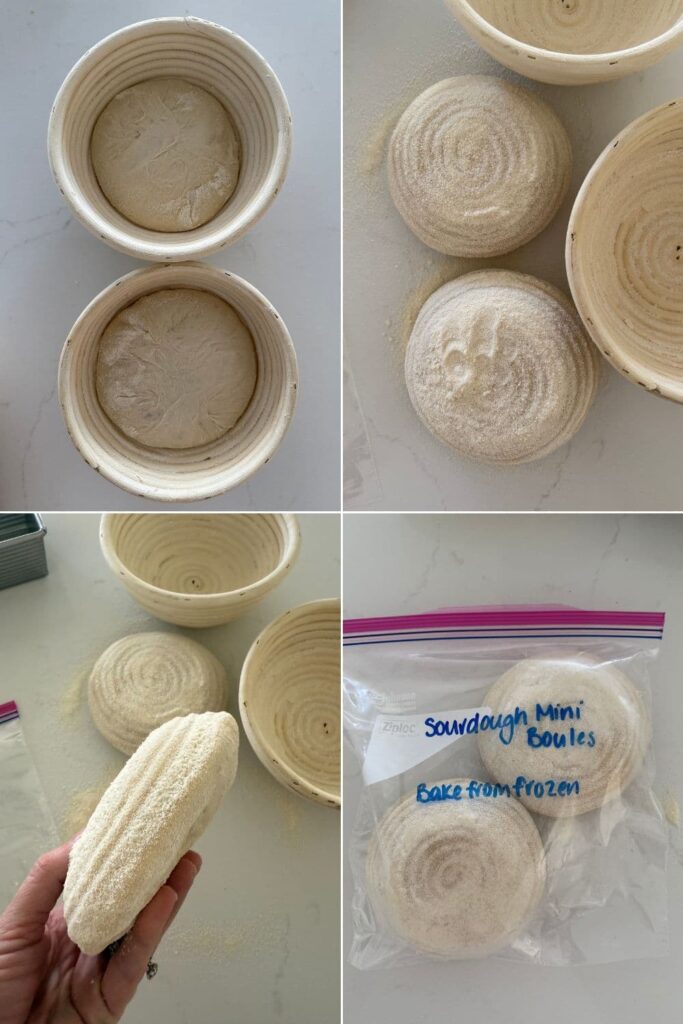
This one baked up much cleaner and had a nicer looker exterior. You really need to make sure you use plenty of semolina or rice flour to stop the dough sticking to the banneton. Only leave the dough inside the banneton for as long as it needs to freeze through. Leaving it in the banneton in the freezer for too long will more than likely make the dough stick to the banneton.
I tried this method with some small sourdough boules using my small batch sourdough recipe. These small sourdough boules were in the freezer for around 2 weeks and baked up beautifully!
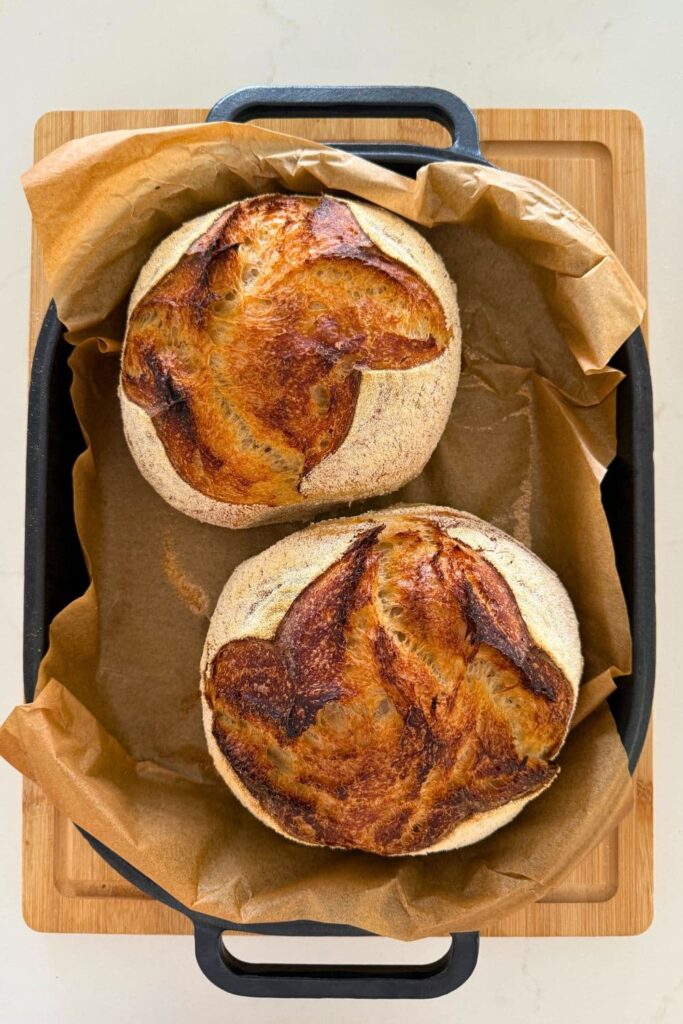

How to Freeze Sourdough In a Loaf Pan
If you've been around here for a while, you'll know how much I love baking sourdough in a loaf pan, so I decided to see what would happen if I froze the dough in a loaf pan. Here's how I did it:
- Mix, bulk ferment and shape the sourdough as per normal.
- Sprinkle a generous amount of semolina flour into a banneton. Place the shaped sourdough into the banneton.
- Cover with plastic and allow to proof for around 30 minutes on the counter before placing the banneton into the fridge. I left the dough in the fridge for 12 hours.
- Then I took a piece of parchment paper and tipped the sourdough onto it with the seam side down.
- Use the parchment paper to place the dough inside a loaf pan (I used a USA Pan Pullman Pan without the lid).
- I placed the dough inside the loaf pan into the freezer until it was frozen through.
- Then I removed the dough from the loaf pan and placed it inside a ziplock bag (you can add more than frozen dough to the bag.
- When you're ready to bake the loaf, place the dough back into the loaf pan and into the oven (I like to use another loaf pan on top to lock in the steam). Bake for 45 minutes at 230C/450F with the loaf pan on top and then 10 minutes at 210C/410F uncovered.
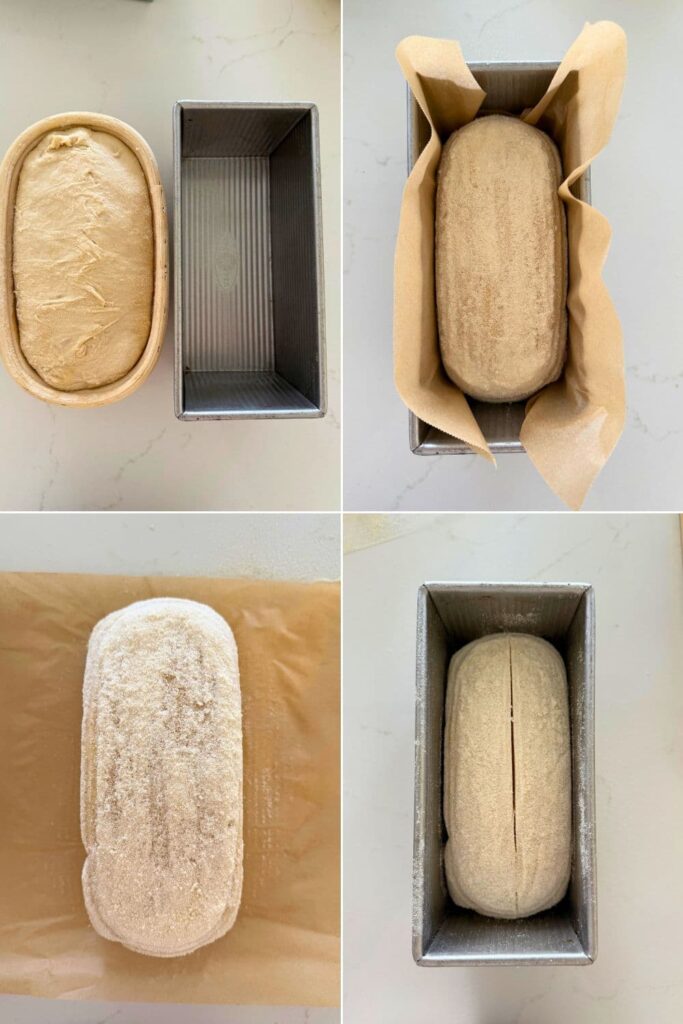
This sourdough loaf, baked from frozen in a loaf pan, turned out amazing! It was definitely my favorite from this whole experiment and one that is easy to recreate. I highly recommend this one if you want to bake sourdough from frozen dough. The crust on this one was just incredible, lovely and crispy with a soft crumb inside. Perfect for making toast!
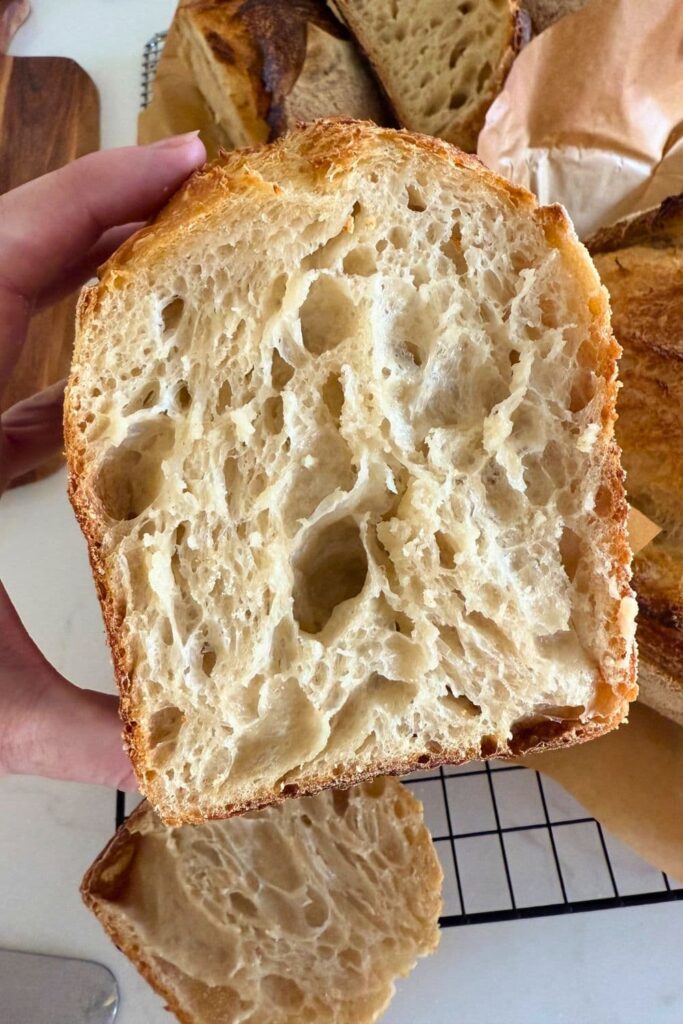
Kate's Recipe Tips
- Don't forget to label and date - It sounds simple, but it’s so easy to forget what’s inside those mystery bundles a month later! Write down the date you froze the dough and what type it is. Trust me on this one!
- Snap Freezing is Your Friend - once the dough has been snap frozen in its proofing container, transfer it into ziplock bags. You can add more than one portion of frozen dough to each ziplock bag and these are much easier to store in the freezer than bannetons or loaf pans.
Should You Thaw Frozen Sourdough Dough Before Baking?
You can thaw your sourdough loaves in the fridge overnight before baking, however, in my experience, this isn't necessary - and can in fact be a disservice to your loaf.
Because you have already bulk fermented and cold proofed the dough before placing it in the freezer, allowing it time to thaw, either on the counter at room temperature, or in the fridge, can risk over fermentation and lack of oven spring when you bake it.
My advice is just to bake your shaped loaf from frozen as I have done above.
How Long Can You Freeze Sourdough Dough?
Generally, shaped sourdough dough can be frozen for up to 3 months without any loss of texture. Freezing the dough for a period of time before baking can in fact increase the sour flavor of your sourdough bread. This might be an advantage if you enjoy a more sour flavor to your sourdough.
Freezing the dough for longer than 3 months can mean it loses it's fermentation power and won't bake up as well. If you want to freeze your dough for longer than 3 months, I would recommend baking it first and then freezing it (use this guide to freezing sourdough bread). Bread that already been baked won't lose it's taste and texture as quickly as unbaked frozen dough will, so is better in terms of long term storage.
Common Mistakes to Avoid
Freezing dough before it’s had enough bulk fermentation - it's really important to ensure your dough has had adequate time to bulk ferment and some proofing time before you place it in the freezer.
Letting air into the wrapping - if you don't wrap the sourdough correctly once it's snap frozen, it will be susceptible to freezer burn. You also don't want icicles to form on the surface of the dough, particularly if you're going to thaw it before you bake it. I like using ziplock bags, but you can use plastic wrap, a freezer bag or even aluminum foil if you prefer. I recommend wrapping the dough in parchment paper before aluminum foil if you're going to use it.
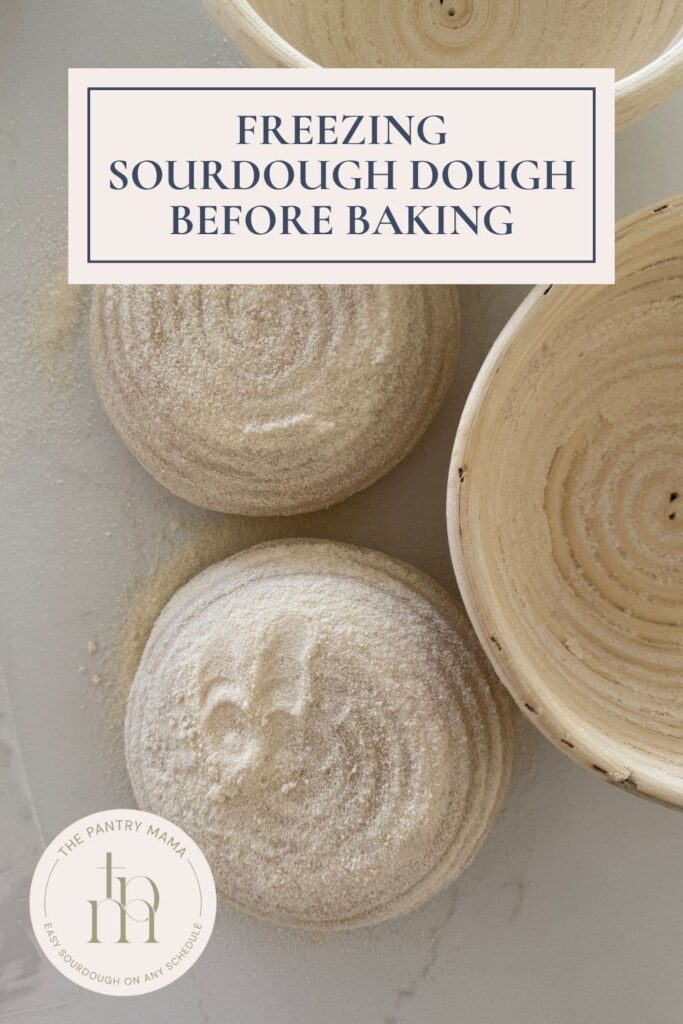
Frequently Asked Questions
You can freeze sourdough dough with mix-ins, however you'll have the most success freezing plain dough. Mix-ins can add extra moisture to the dough which can cause problems, particularly if you allow the dough to thaw before you bake it.
Absolutely, yes you can bake sourdough straight from frozen. In fact this is my preferred method of baking frozen sourdough. Allowing the dough to thaw can compromise the integrity of the dough.
Absolutely, you can freeze sourdough sandwich bread and then bake it. It's best to allow the sourdough sandwich dough to thaw a little before baking. It doesn't have to thaw all the way through, but not frozen solid.


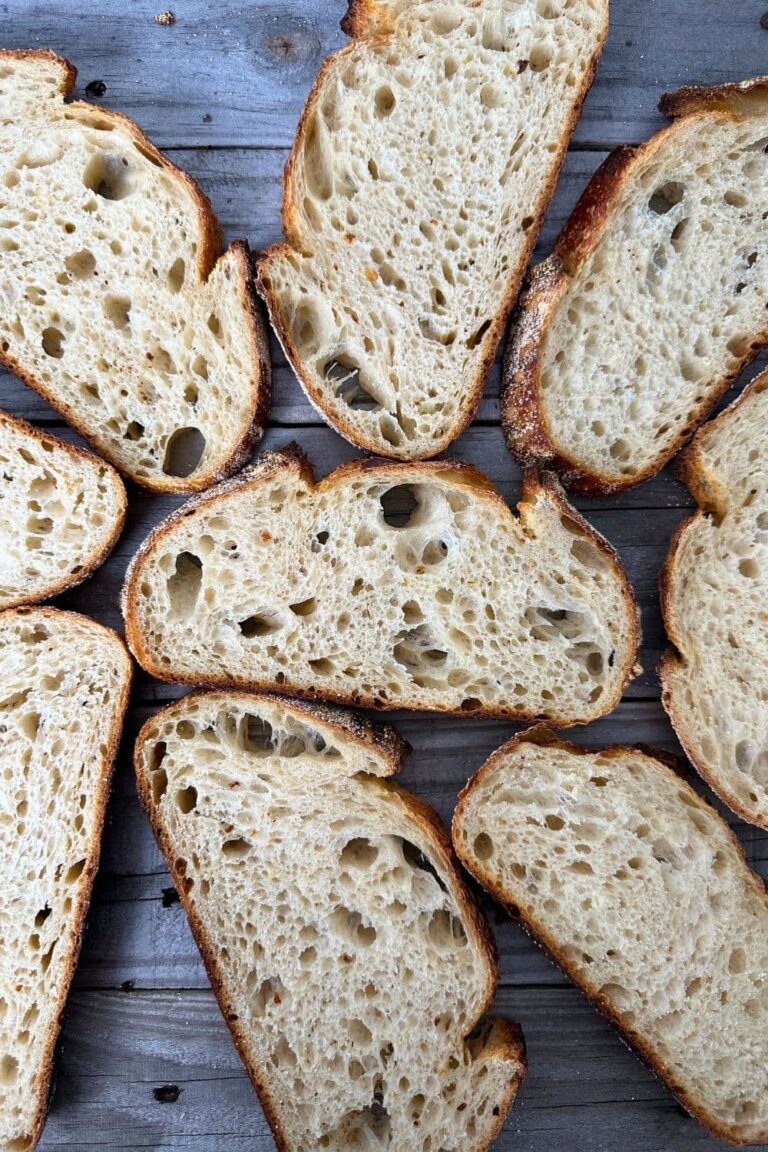
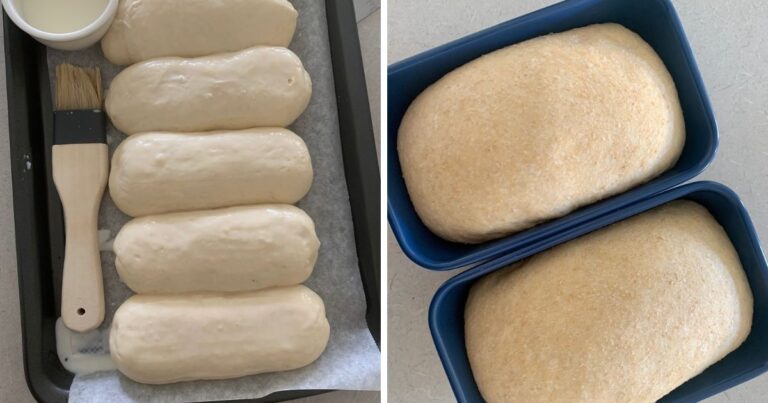
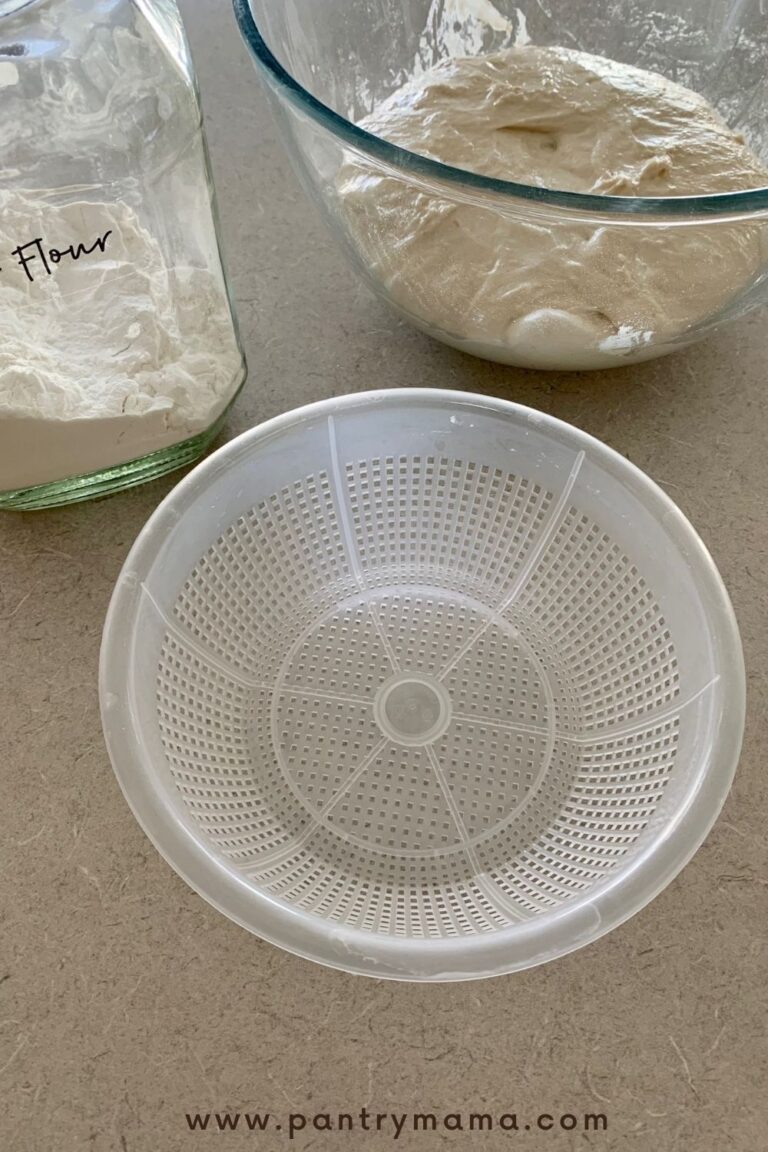
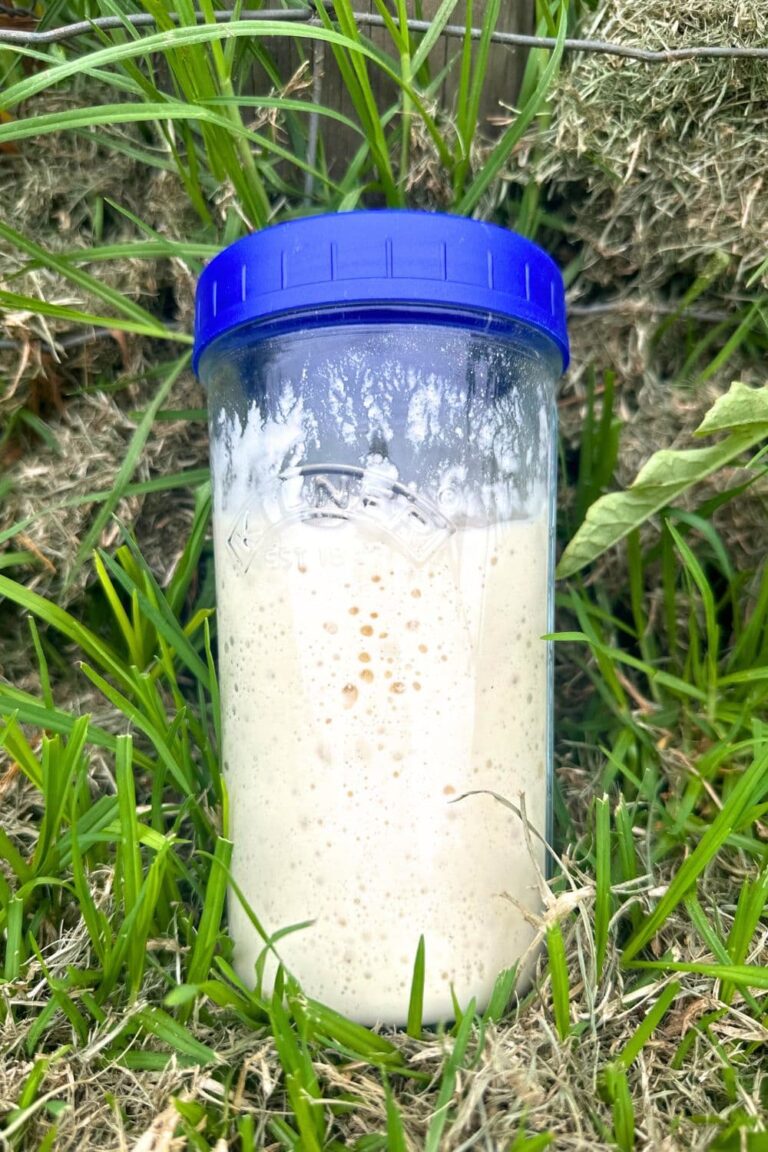

I love this idea and will try it with my next batch. A question to clarify though...
the best time to freeze noted early in the article is "After bulk fermentation but before final shaping (most recommended)." But the instructions later say to freeze in the dough in the generously floured banetton after mixing, bulk fermenting and shaping. Am I missing a step? Thanks Kate, and your recipes are the best!
That is a good point and I will fix it - I experimented so much with the timing of this and experimented freezing the dough before the shaping, but then found that it was problematic, so you're right I need to remove this part! Thank yo so much for pointing this out 🙂
Hi Kate
Do you need to score your dough before it goes into the freezer or do you just let it burst naturally? Or can you freeze for 30min to and hour, score then continue freezing?
You can definitely let it burst naturally, this can create a really lovely, rustic looking loaf. You can also score after freezing for an hour yes. Or you can use a sharp knife to score when frozen before placing into the oven 🙂 You might not be able to score too deep, but it will be enough to control the opening of the dough 🙂
Hi, I'm intrigued as to when do you score the frozen dough, and will a normal lame do it?
I scored the loaf before I put it in the oven, but no, a regular lame won't be able to do it as the blade is too thin. A sharp kitchen knife is better. You don't even need to score it if you don't want to, you can let it open up naturally and create a lovely, rustic loaf if you want to 🙂
Thank you so much Kate! I have been following you for a while and learned a lot and this post has come at just the right time!
I do have a query ….. if planning to bake the dough in a pan, why do you recommended proving it in a banetton and then moving it to the pan before freezing? Would it be possible to put the dough into the pan to prove in the fridge and then freeze it? Just wondering what the benefit is. Many thanks
I'm so glad that this post is timely for you Ruth. I found it easiest to get the dough out of the banneton when frozen, whereas it was harder with the loaf pan, so I chose to proof in the banneton and then place in the loaf pan to bake, but you can do it however it works best for you 🙂 xo
I may have missed it but when would you score the loaf? I am looking forward to trying this method. Thank you.
I scored the loaf while it was frozen before it went into the oven, I used a sharp craft knife to score the frozen dough 🙂